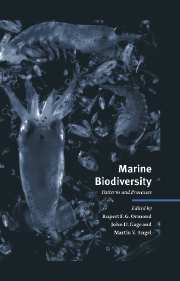Book contents
- Frontmatter
- Contents
- List of contributors
- Foreword: The value of diversity
- 1 Marine biodiversity in its global context
- 2 Gradients in marine biodiversity
- 3 Pelagic biodiversity
- 4 Biological diversity in oceanic macrozooplankton: More than counting species
- 5 Large-scale patterns of species diversity in the deep-sea benthos
- 6 Diversity, latitude and time: Patterns in the shallow sea
- 7 High benthic species diversity in deep-sea sediments: The importance of hydrodynamics
- 8 Diversity and structure of tropical Indo-Pacific benthic communities: Relation to regimes of nutrient input
- 9 Why are coral reef communities so diverse?
- 10 The biodiversity of coral reef fishes
- 11 The historical component of marine taxonomic diversity gradients
- 12 Population genetics and demography of marine species
- 13 Discovering unrecognised diversity among marine molluscs
- 14 Ecosystem function at low biodiversity – the Baltic example
- 15 Land–seascape diversity of the USA East Coast coastal zone with particular reference to estuaries
- 16 The development of mariculture and its implications for biodiversity
- 17 Protecting marine biodiversity and integrated coastal zone management
- 18 Conserving biodiversity in North-East Atlantic marine ecosystems
- Author index
- Species index
- Subject index
Foreword: The value of diversity
Published online by Cambridge University Press: 04 August 2010
- Frontmatter
- Contents
- List of contributors
- Foreword: The value of diversity
- 1 Marine biodiversity in its global context
- 2 Gradients in marine biodiversity
- 3 Pelagic biodiversity
- 4 Biological diversity in oceanic macrozooplankton: More than counting species
- 5 Large-scale patterns of species diversity in the deep-sea benthos
- 6 Diversity, latitude and time: Patterns in the shallow sea
- 7 High benthic species diversity in deep-sea sediments: The importance of hydrodynamics
- 8 Diversity and structure of tropical Indo-Pacific benthic communities: Relation to regimes of nutrient input
- 9 Why are coral reef communities so diverse?
- 10 The biodiversity of coral reef fishes
- 11 The historical component of marine taxonomic diversity gradients
- 12 Population genetics and demography of marine species
- 13 Discovering unrecognised diversity among marine molluscs
- 14 Ecosystem function at low biodiversity – the Baltic example
- 15 Land–seascape diversity of the USA East Coast coastal zone with particular reference to estuaries
- 16 The development of mariculture and its implications for biodiversity
- 17 Protecting marine biodiversity and integrated coastal zone management
- 18 Conserving biodiversity in North-East Atlantic marine ecosystems
- Author index
- Species index
- Subject index
Summary
The current debate about the diversity of life is relatively new. That on marine biodiversity has hardly started. It has been created not by some new appreciation of the marvels of nature – would that it were – but by the evident destruction of the natural world as we and our ancestors have known it. When discussion of an international treaty on biodiversity began, there were many who asked why we should worry, or who gave it low priority in comparison with such problems as human poverty or the hazards of climate change. The answers are both simple and complex.
Change and its impact
The sea is our mother and father. All life comes from it. It is still far richer in major groupings of animals than the land: of 34 animal phyla, 29 occur in the sea, and 14 of them only in the sea. The complexity of its species and ecosystems is immense. Yet, as on land, we are engaged in a process of extinguishing populations and ecosystems at something like 1000 times the natural rate. Globally, the present rate of species extinction is comparable to the extinctions at the end of the Cretaceous period 65 million years ago when the long dominance of the dinosaurs came to an end.
How is it that one animal species – our own – could have had such destructive effects on others?
- Type
- Chapter
- Information
- Marine BiodiversityPatterns and Processes, pp. xiii - xxiiPublisher: Cambridge University PressPrint publication year: 1997
- 3
- Cited by



